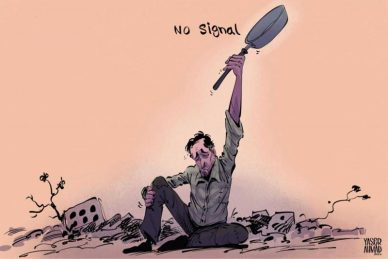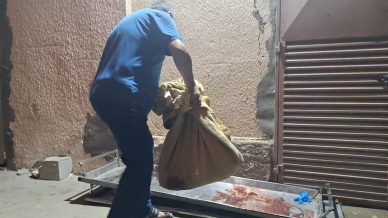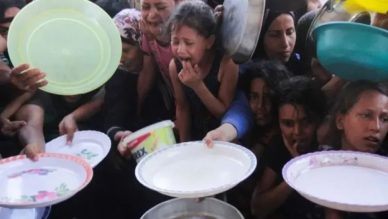GAZA, (PIC)
Mahmoud Radwan sits among the ruins of his destroyed home, contemplating an uncertain future amidst a labor crisis unlike any before—what he describes as the worst in decades.
Before the outbreak of Israel’s genocidal war on October 7, 2023, Radwan, 45, worked in the construction sector—a vital industry in Gaza. He has since lost his only source of income. A father of six, two of whom are university students, Radwan describes Gaza’s labor market as bleak and virtually nonexistent: “There is no work, and the war has imposed a high cost of living. When we do find a job, the wages barely cover food and drink for the family.”
Until the ceasefire was announced on January 19, Radwan, like hundreds of others, turned to buying and selling food supplies—mainly canned goods provided by international aid organizations. These were often surplus items that families sold to meet other needs. However, the situation dramatically deteriorated when the Israeli occupation reneged on the three-phase agreement on March 2 and resumed its genocidal war on March 18.
“With the war halted for 40 days, we had a glimmer of hope,” Radwan says. “I did some repair work on homes partially restored for living, but things have gone back to worse than before the ceasefire. Today, we can’t buy anything for our families—not because there’s nothing to buy, but because we have no money. And those who do have money can’t pay wages due to the financial blockade and lack of cash liquidity.”
Unemployment soars
According to data from the Palestinian Central Bureau of Statistics, unemployment in the Gaza Strip reached around 68% during the fourth quarter of 2024, up from 45% in the third quarter of 2023.
In a press release issued on the eve of Labor Day (May 1), the Bureau noted that labor force participation dropped to around 30%, down from 40% in the third quarter of 2023, prior to October 7.
The labor force survey revealed that young people (aged 15–29) were particularly affected, with about 74% now outside education, training, and employment.
The Bureau also noted that the genocidal war’s impact extended to the West Bank, though to a lesser extent. It confirmed that the Israeli aggression on Gaza triggered widespread consequences in the West Bank.
These included intensified restrictions across West Bank governorates, fragmented internal connectivity, and a ban on workers entering Israeli territory, effectively paralyzing the economy. The number of unemployed people in the West Bank rose to 313,000 in 2024, compared to around 183,000 in 2023.
Collapse of the productive sector
The ongoing genocidal war in Gaza has brought local industrial production to a halt, following the massive destruction and leveling of hundreds of facilities and factories that had employed more than 250,000 workers.
The war has devastated Gaza’s already fragile economy, crippled by over 18 years of siege, bringing Palestinians back to square one, facing a long and uncertain journey of reconstruction—if such an opportunity ever arises.
During the war (October 7, 2023 – January 19, 2024), most commercial activities came to a standstill in the early days. Israeli forces deliberately targeted industrial, commercial, and economic facilities with airstrikes and ground operations.
Ziyad Al-Agha, owner of a factory in Khan Yunis specializing in agricultural and plastic piping, says his factory—like thousands of others—suffered immense damage, paralyzing the city’s industrial activity, which had not fully recovered from previous wars.
His factory used to produce 5,000 meters of plastic daily. He estimates his losses at around half a million dollars, covering direct damages to storage areas, goods, raw materials, and machinery.
Industry in Gaza is considered the backbone of its economy, given the right conditions. It spans several sectors that meet local needs and even support exports. Key industries include garment manufacturing (which Israel permits for export), furniture production, plastic and sponge products, foodstuffs, and soft drinks.
In 2019, Gaza had 1,247 operating factories employing about 16,360 people, with a production capacity of 32%. By 2020, the number rose to 1,349 factories but with fewer employees (14,770), and production capacity plunged to 14.5%. In 2021, the number declined again to 1,212 factories, employing roughly 18,295 people, with a production rate of 22%.
While no precise data is available on the damage to Gaza’s industrial sector during the current war, the Palestinian Investment Promotion and Industrial Cities Authority estimated in December 2023 that dozens of factories in Gaza’s industrial city were either partially or completely destroyed. A solar power project there lost 40–50% of its production capacity due to the war.
The Karni Industrial Zone includes 72 factories across various sectors, such as textiles, food and beverage manufacturing, plastics, woodwork, pharmaceuticals, and detergents, in addition to local and international companies.
The city provides over 6,400 daily job opportunities, directly and indirectly, and spans 480 dunums east of Gaza City.
Since October 7, 2023, Israel has waged a genocidal war on the Gaza Strip, resulting in over 170,000 martyrs and wounded, 10,000 missing (most of them women and children), and massive destruction of infrastructure.














